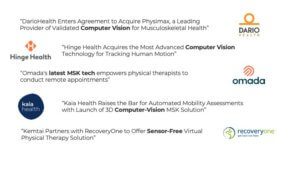Computer vision applications have become critical in many industries, including automotive, healthcare and manufacturing. With its potential to aid humans in performing physical tasks with better accuracy and consistency, computer vision is increasingly being used across a wide range of applications. Digital Health and Physical Therapy in particular seem to be awakening to the myriad possibilities and benefits of utilizing computer vision technology, for the benefit of providers and patients.
What is MSK Physiotherapy?
Musculoskeletal therapy or “MSK” is one such application where physical therapists guide or move the patient’s body in order to relieve pain and increase mobility after injuries or disease. As an emerging field, MSK has experimented with the potential of technology using motion tracking with sensors and wearables. However, sensor-based technology has proven to be expensive, complicated to use and ill-suited for scaling. In recent times, the rise of computer vision technology in musculoskeletal therapy is turning the tide, making diagnostics more efficient, treatment more accurate and patient-therapist engagement seamless. The potential for the industry to leverage the power of computer vision in MSK is proving to be substantial, with significant implications for patient engagement and outcomes.
Global trends in the Digital MSK market
Musculoskeletal care is a big market for digital health companies, according to industry analysts. The prevalence of musculoskeletal diseases, a growing geriatric population, and rapid technological advancements are some of the factors responsible for the growth of this market.
Most MSK issues, though common, have proven expensive to treat since many people lack access to accurate diagnostics and dependable care that could help them lower their treatment costs. This gap in the market is starting to be slowly bridged by digital healthcare companies leveraging AI motion tracking and computer vision technology. In the past year, digital MSK startups have either built or acquired technologies to further strengthen their offerings. Hinge Health which raised close to $1B in funding last year acquired Wrnch. This shows an interesting trend of the industry veering towards computer vision technology. Hinge is one of the market leaders that has so far relied on sensor-based motion tracking. Their acquisition of Wrnch, a platform that combines computer vision and motion sensing technology to deliver personalized digital physical therapy, clearly demonstrates the direction of the digital MSK market.
Kaia Health which already boasts of computer vision capabilities raised $75M in series C last year. SpineZone, and RecoveryOne in the digital MSK space attracted VC investments of $12M and $33M respectively in 2021. Meanwhile, DarioHealth, which offers tools for managing chronic conditions like hypertension and diabetes, used its funding to acquire Upright Technologies — a startup that makes software tackling MSK issues. In October 2021 the company launched Dario Move: a platform for treating musculoskeletal problems. Further to this, DarioHealth has acquired Physimax, a leading provider of validated computer vision for musculoskeletal health. SWORD Health valued at $2 billion bought Vigilant Technologies, maker of a wearable that aims to prevent workplace injury. Further, the company has started using computer vision for wrist therapy exercises.
The global market for computer vision technology-enabled healthcare is poised to hit $5.15 billion by 2026. The adoption of this technology in line with financial prediction has been rapid among companies that provide MSK solutions.
MSK Therapy Through Computer Vision Technology
Apart from assisting with patient treatment and recovery, Digital MSK platforms have a pressing need to empower therapists in their daily workflow, patient tracking, and timely feedback easy and data-enabled. This step alone could go a long way in reducing the number of patients moving to the surgery stage which is expensive and the resulting recovery complicated. This change may also improve the performance and time capacity of the therapist thereby increasing their capability to receive more patients and expand their income.
An essential step for enabling digital MSK is the timely availability of the therapist and relevant feedback for the patient. By incorporating appointments aided by video and AI-based motion analysis, companies such as Omada are bringing the therapist and his expertise to the patient’s living room. Omada’s latest tech for MSK enables physical therapists to conduct remote appointments. This is a step forward for digital MSK, as it allows patients to receive the care they need when they need it. The ability to remotely monitor patient status and progress can also help physical therapists identify red flags early on and intervene before an acute injury becomes chronic. When coupled with data-driven insights from wearable devices, it’s possible to deliver high-quality care at scale.
Some digital MSK startups have taken a step further towards effective remote assessment of patient movement. Kaia Health has unveiled a computer-vision solution for automatically assessing patient mobility. The technology creates a full 3D model of the body, removing the need for the restrictive placement of phones or sensors. It tracks important skeletal structures with an eye to what clinicians care about most resulting in unparalleled precision!
The advancement of digital care using computer vision technology seems to be the hot trend in Digital Health and is being readily adopted by all serious players in the digital MSK space. This is a welcome move that promises to bring down the cost of healthcare and improve patient outcomes.
Kemtai’s Musculoskeletal Health Partnerships
Kemtai’s computer vision and artificial intelligence technology-infused exercise platform provides real-time feedback and adaptive corrective guidance to its users. Recently, Kemtai has partnered with RecoveryOne, a pioneering health technology company working to improve the path to recovery for musculoskeletal injury thereby making the recovery cheaper and accessible to the patient.
RecoveryOne’s Motion Trainer is a new program that gives recovery patients real-time feedback on their exercise form, eliminating the need for wearable sensors. Accessing Kemtai’s API framework, Motion Trainer uses the built-in camera of a user’s device to provide real-time guidance and movement quality scoring that is unprecedented— a quantum leap from follow-along exercise videos. The adaptability and scalability of Kemtai’s AI technology platform enable it to evolve innovative solutions that could improve patient care while reducing costs. Motion Trainer offers individuals an virtual physical therapy solution that gives them the feeling of having their own personal therapist at their side the whole time, providing real-time feedback and corrective guidance throughout their recovery.
Another feather in the cap is kemtai’s partnership with 180 MSK Systems, whose end-to-end platform provides clinics with the tools that they need to provide patients with better care by fusing physical treatment into virtual programs. The new version of 180 MSK Systems’ virtual musculoskeletal platform, powered by Kemtai, provides patients with real-time feedback and guidance during at-home sessions—meaning they no longer need sensors or other hardware that could hinder adherence.
MotionTrainer and the improved 180 MSK platform represent the first in a series of products that will be built on Kemtai’s AI technology platform. The company has already begun developing other applications that could help patients with conditions where mobility is impaired. To learn more about Motion Trainer or Kemtai’s other healthcare solutions, please visit www.kemtaistg.wpenginepowered.com.
In closing …
The healthcare industry has been ripe for technology disruption. As patients demand more personalized and convenient care, providers are struggling to meet the rising demand while maintaining high-quality standards. The existing system is complex, fragmented, and inefficient, which leads to high costs and poor outcomes for patients.
It is time for motion tracking for physiotherapy exercises to evolve from a sensor-based, wearable and expensive hardware driven technology. Imbibing computer vision technology and harnessing the growing power of AI, motion tracking technology could now enable a series of innovations in digital health that have the potential to be game-changing for the industry. It is safe to say that advancements in AI and Computer Vision have opened up new opportunities for digital health and will be used to potentially improve the quality of life for patients around the world.



